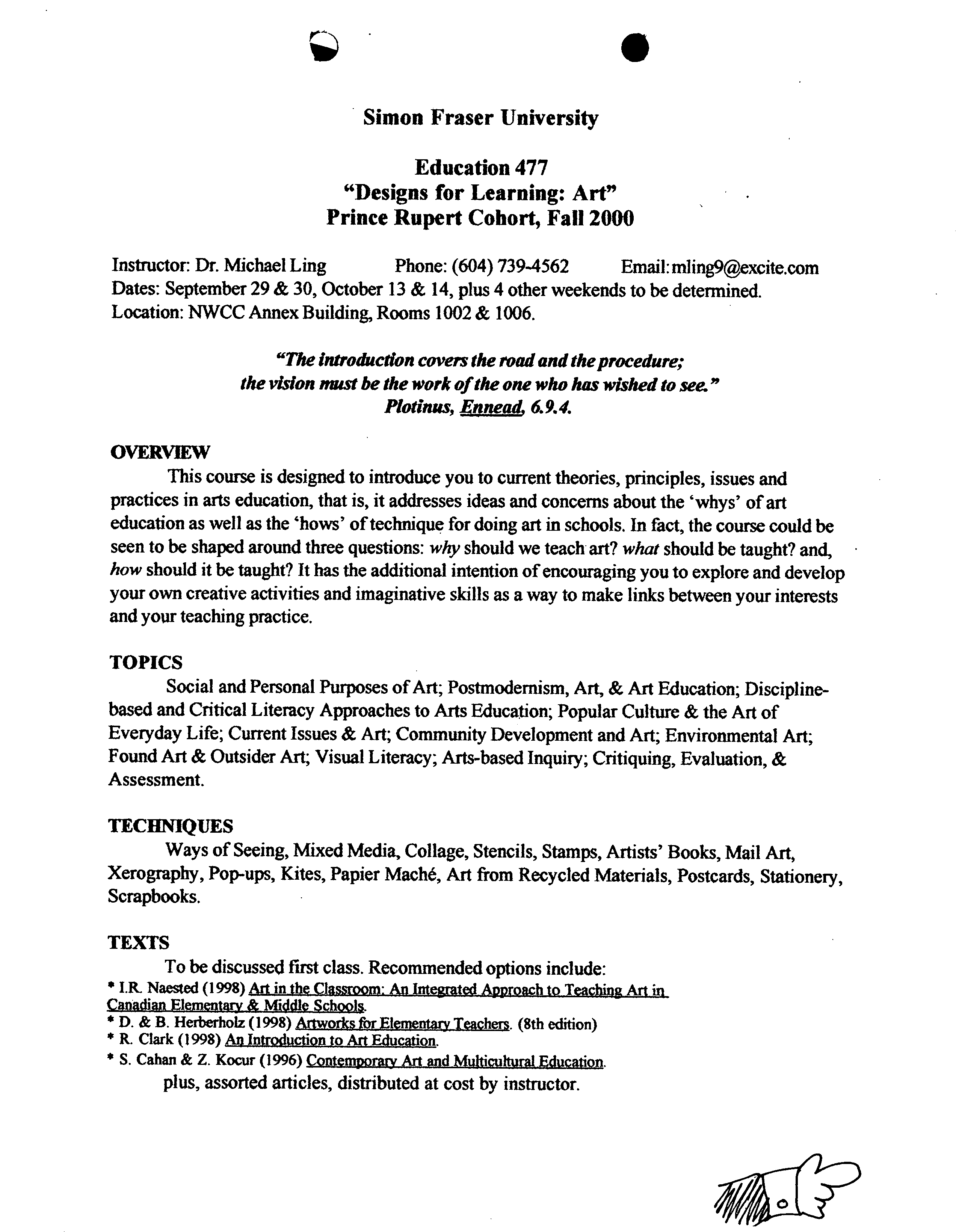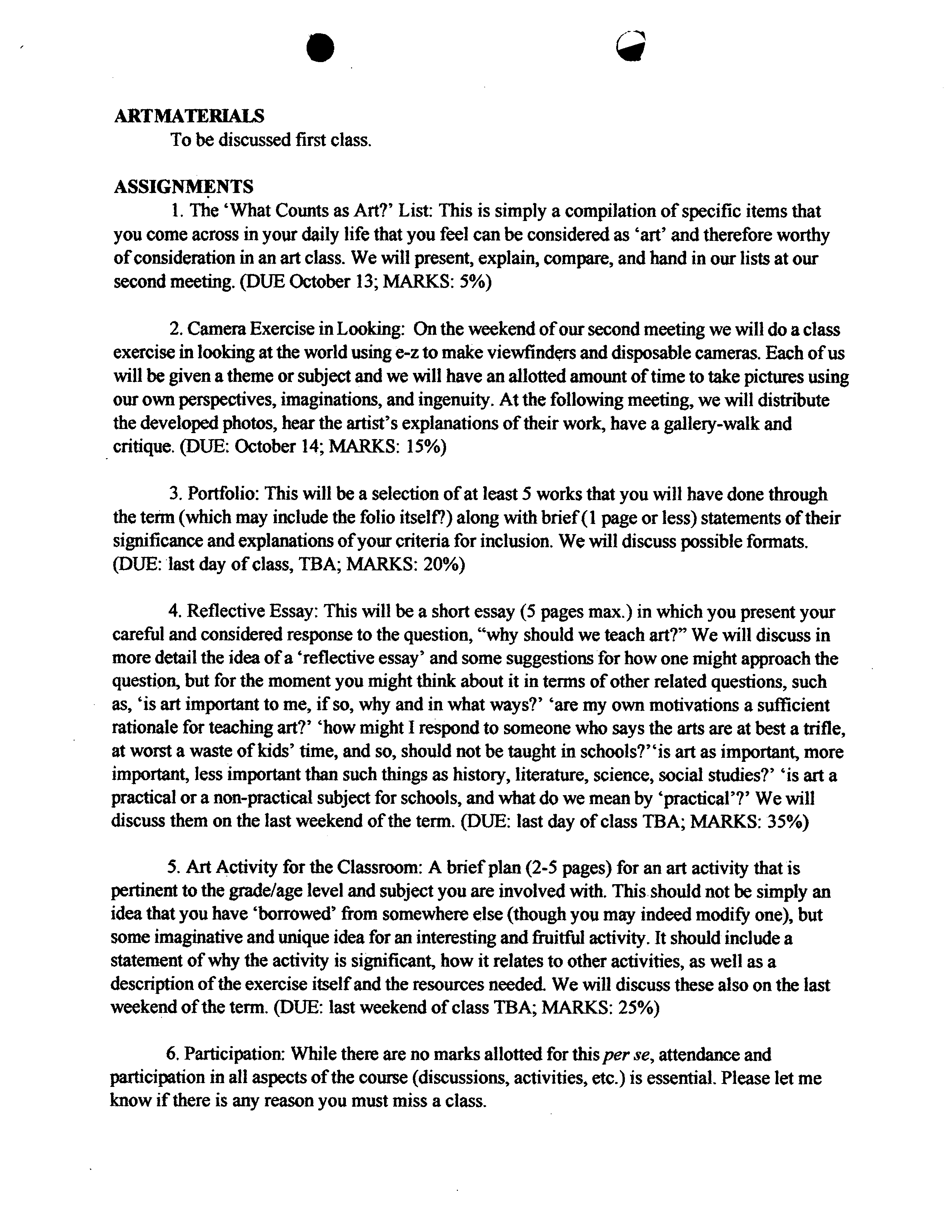Simon Fraser University
Education 477
"Designs for Learning: Art"
Prince Rupert Cohort, Fall 2000
Instructor: Dr. Michael Ling
?
Phone: (604)
7394562 ?
Email:mling9excite.com
Dates: September 29 & 30, October 13 & 14, plus 4 other weekends to be determined.
Location: NWCC Annex Building, Rooms 1002 & 1006.
"The introduction covers the road and the procedure;
the vision must be the work oldie one who has wished to see."
?
Plotinus, Ennead. 6.9.4.
OVERVIEW
This course is designed to introduce you to current theories, principles, issues and
practices in arts education, that is, it addresses ideas and concerns about the 'whys' of art
education as well as the 'hows' of technique for doing art in schools. In fact, the course could be
seen to be shaped around three questions:
why
should we teach art?
what
should be taught? and,
how
should it be taught? It has the additional intention of encouraging you to explore and develop
your own creative activities and imaginative skills as a way to make links between your interests
and your teaching practice.
TOPICS
Social and Personal Purposes of Art; Postmodernism, Art, & Art Education; Discipline-
based and Critical Literacy Approaches to Arts Education; Popular Culture & the Art of
Everyday Life; Current Issues & Art; Community Development and Art; Environmental Art;
Found Art & Outsider Art; Visual Literacy; Arts-based Inquiry; Critiquing, Evaluation, &
Assessment.
TECILNIQIJES
Ways of Seeing, Mixed Media, Collage, Stencils, Stamps, Artists' Books, Mail Art,
Xerography, Pop-ups, Kites, Papier Mache, Art from Recycled Materials, Postcards, Stationery,
Scrapbooks.
TEXTS
To be discussed first class. Recommended options include:
*
JR
Naested (1998) Art in the Classroom: An integrated Approach to Teaching Art in
Canadian Elementaiy & Middle School&
* D. & B. Herberholz (1998) Artworks for Elementary Teachers. (8th edition)
* R.
Clark (1998) An Introduction to Art Education.
* S.
Cahan & Z. Kocur (1996) Contemoorarv Art and Multicultural Education.
plus, assorted articles, distributed at cost by instructor.
moo,""
.
Y
I"N' -- ra
S ?
4
ART MATERIALS
To be discussed first class.
ASSIGNMENTS
1. The 'What Counts as Art?' List: This is simply a compilation of specific items that
you come across in your daily life that you feel can be considered as 'art' and therefore worthy
of consideration in an art class. We will present, explain, compare, and hand in our lists at our
second meeting. (DUE October 13; MARKS:
5%)
2.
Camera Exercise in Looking: On the weekend of our second meeting we will do a class
exercise in looking at the world using e-z to make viewfinders and disposable cameras. Each of us
will be given a theme or subject and we will have an allotted amount of time to take pictures using
our own perspectives, imaginations, and ingenuity.
At the following meeting, we will distribute
the developed photos, hear the artist's explanations of their work, have a gallery-walk and
critique. (DUE: October 14; MARKS:
15%)
3.
Portfolio: This will be a selection of at least
5
works that you will have done through
the term (which may include the folio itself?) along with brief (I page or less) statements of their
significance and explanations of your criteria for inclusion. We will discuss possible formats.
(DUE: last day of class, TEA; MARKS: 20%)
4.
Reflective Essay: This will be a short essay
(5
pages max.) in which you present your
careful and considered response to the question, "why should we teach art?" We will discuss in
more detail the idea of a 'reflective essay' and some suggestions for how one might approach the
question, but for the moment you might think about it in terms of other related questions, such
as, 'is art important to me, if so, why and in what ways?' 'are my own motivations a sufficient
rationale for teaching art?' 'how might I respond to someone who says the arts are at best a trifle,
at worst a waste of kids' time, and so, should not be taught in schools?" is art as important, more
important, less important than such things as history, literature, science, social studies?' 'is art a
practical or a non-practical subject for schools, and what do we mean by 'practical'?' We will
discuss them on the last weekend of the term. (DUE: last day of class TEA; MARKS:
35%)
5. Art Activity for the Classroom: A brief plan
(2-5
pages) for an art activity that is
pertinent to the grade/age level and subject you are involved with. This should not be simply an
idea that you have 'borrowed' from somewhere else (though you may indeed modify one), but
some imaginative and unique idea for an interesting and fruitful activity. It should include a
statement of why the activity is significant, how it relates to other activities, as well as a
description of the exercise itself and the resources needed. We will discuss these also on the last
weekend of the term. (DUE: last weekend of class TEA; MARKS:
25%)
6.
Participation: While there are no marks allotted for this
per se,
attendance and
participation in all aspects of the course (discussions, activities, etc.) is essential. Please let me
know if there is any reason you must miss a class.


